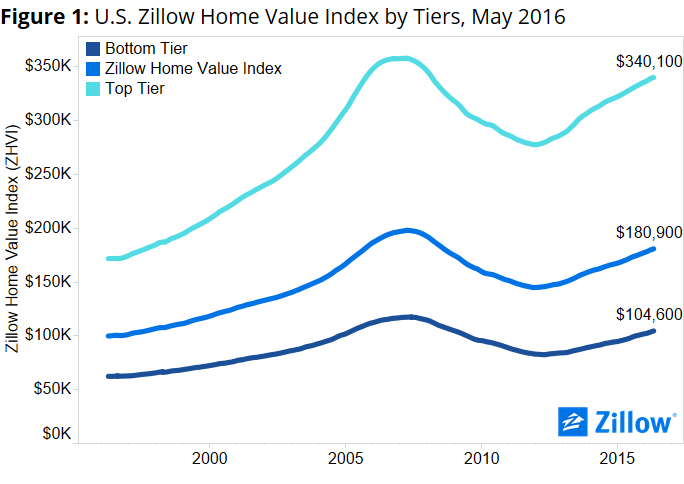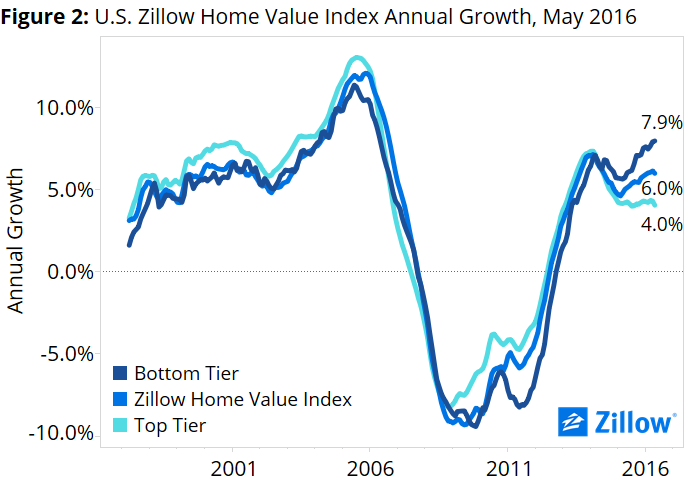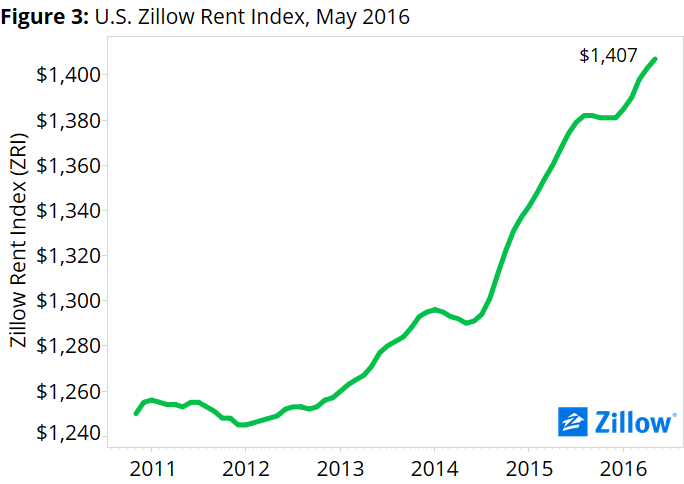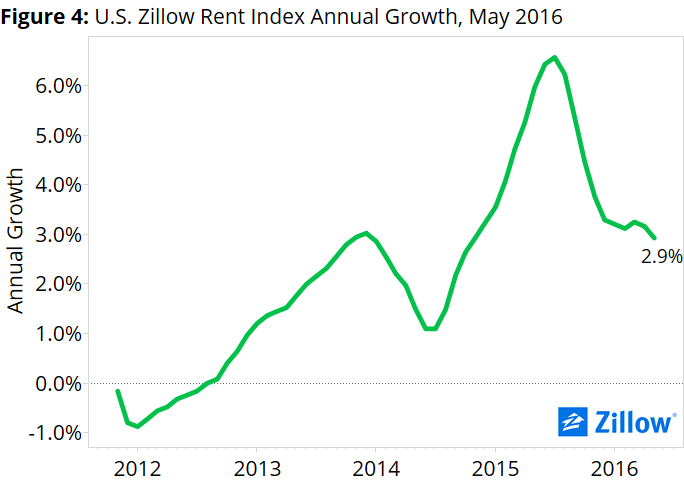Uncategorized
May 2016 Market Report: Bottom-Tier Volatility and Top-Tier Stability Reveals A Tale of Two Markets
Rapid and accelerating growth in entry-level U.S. home values, and the affordability squeeze it’s causing for the market’s core, has gained a lot of attention lately. But flying largely under the radar has been an almost year-and-a-half-long stabilization in home value growth among top-tier U.S. homes.
- Entry-level home values rose twice as fast (8 percent) over the past year as top-tier home values.
- The number of expensive homes for sale has remained steady, but there are fewer entry-level homes on the market.
- Nationally, home values rose 5.4 percent over the past year, to a median home value of $186,100. Rents rose 2.9 percent to a Zillow Rent Index[i] of $1,407.
Rapid and accelerating growth in entry-level U.S. home values, and the affordability squeeze it’s causing for the market’s core, has gained a lot of attention lately. But flying largely under the radar has been an almost year-and-a-half-long stabilization in home value growth among top-tier U.S. homes.
 The median U.S. home value in May rose to $186,100, according to the Zillow Home Value Index, up 5.4 percent year-over-year and 0.5 percent from April. The typical entry-level home was worth $104,600 in May and the median top-tier home was worth $340,100. Home values among entry-level homes have grown almost twice as fast over the past year as home values among top-tier homes – 7.9 percent compared to 4 percent, respectively (figure 1).
The median U.S. home value in May rose to $186,100, according to the Zillow Home Value Index, up 5.4 percent year-over-year and 0.5 percent from April. The typical entry-level home was worth $104,600 in May and the median top-tier home was worth $340,100. Home values among entry-level homes have grown almost twice as fast over the past year as home values among top-tier homes – 7.9 percent compared to 4 percent, respectively (figure 1).
And while annual home value growth among bottom-tier homes nationwide has been faster than the month prior in 12 of the past 14 months, home value growth among top-tier homes has been remarkably constant over the past roughly year-and-a-half. After peaking at 7.3 percent annual growth in early 2014 and steadily slowing down each month for a year after, U.S. top-tier home values have grown at a 4 percent to 4.3 percent year-over-year pace in every month since January 2015 (figure 2).
 This trend is echoed in a majority of large markets nationwide. Top-tier home value growth is slowest among all three tiers in 25 of the top 35 markets where home value appreciation data for all three tiers is available. Still, higher-end homes are appreciating more quickly than entry-level homes in pockets of the country, including large markets in the Northeast, West and Midwest. Notable metro markets where annual top-tier home value growth is outpacing bottom-tier growth include New York, Boston, Seattle, St. Louis and Cleveland.
This trend is echoed in a majority of large markets nationwide. Top-tier home value growth is slowest among all three tiers in 25 of the top 35 markets where home value appreciation data for all three tiers is available. Still, higher-end homes are appreciating more quickly than entry-level homes in pockets of the country, including large markets in the Northeast, West and Midwest. Notable metro markets where annual top-tier home value growth is outpacing bottom-tier growth include New York, Boston, Seattle, St. Louis and Cleveland.
It’s tough to pin down one exact reason for this stability at the top, even as the bottom and middle segments of the market continue to accelerate. Instead, it’s very likely the result of several factors. The inventory of low- and middle-tier homes for sale fell by 8.9 percent and 9.7 percent, respectively, in May compared to a year ago. Top-tier inventory, over the same period, fell a scant 0.5 percent.
Nationwide in May, less than a quarter (24.6 percent) of all homes for sale were entry-level, bottom-tier homes. On the flip side, almost half (47.5 percent) of all U.S. homes for sale in May were in the top tier. This lack of inventory at the bottom end, combined with high demand from the young families and renters-turned-home buyers that are most likely to seek an entry-level home, helps to push up prices more quickly for those bottom-tier homes that are available. Yes, there is ample-enough demand for higher-end homes to push up home values in that segment at a healthy pace, but that demand simply doesn’t match the clamor for homes at lower price points.
We’ve also been hearing for some time that home builders, who help add to supply when inventory of existing homes for sale is tight, have been more focused on building larger, more expensive homes rather than smaller, more entry-level homes. This additional supply at the high end can also contribute to stability there, even as growth at the low end speeds up.
Regardless of the precise reasons why the top is stable while the bottom is hot, the stark difference between the top and bottom of the housing market sheds light on the two very different experiences home buyers will face this summer in most markets. Buyers looking for the most expensive homes will find more options and less competition. It’s a much different story for entry-level buyers, who will be up against rising prices, low inventory and tough competition, with homes selling over asking price in many of the nation’s hottest housing markets.
Don’t Forget Rising Rents
 The U.S. median rent in May was $1,407 per month (figure 3), up 0.3 percent from April and 2.9 percent from May 2015, according to the Zillow Rent Index.
The U.S. median rent in May was $1,407 per month (figure 3), up 0.3 percent from April and 2.9 percent from May 2015, according to the Zillow Rent Index.
U.S. rents have grown year-over-year for 45 consecutive months (figure 4). But while rents overall have continued to grow for almost four straight years, the pace of annual growth has fallen in recent months. After peaking at 6.6 percent annual growth in July of last year, annual growth has slowed in nine of the 10 months since when compared to the month prior. And this slowdown has been particularly dramatic lately on luxury apartment rents in higher-end ZIP codes in many markets nationwide. A direct, three-tier-based, metro-metro comparison with home value growth is unavailable, but the similarities between the relatively slow growth of top-tier home values and upper-echelon rents is notable.
 Median rents in all of the nation’s 35 largest metro markets grew year-over-year to some extent in May. Rents grew fastest year-over-year in the Portland (up 9.4 percent from May 2015), Seattle (up 9.1 percent) and San Francisco (up 8.4 percent) metros.
Median rents in all of the nation’s 35 largest metro markets grew year-over-year to some extent in May. Rents grew fastest year-over-year in the Portland (up 9.4 percent from May 2015), Seattle (up 9.1 percent) and San Francisco (up 8.4 percent) metros.
Outlook
Looking ahead, Zillow expects national home values to continue growing, rising another 3.1 percent through May 2017 to a Zillow Home Value Index of $191,800. U.S. rents are also expected to keep growing over the next year, at a 3.2 percent pace through May 2017 to a Zillow Rent Index of $1,452.
The top of the market is starting to stabilize, and people are beginning to take notice. Buyers looking for entry-level homes are having bidding wars in many markets, while it’s not uncommon for high priced homes to stay on the market a few months longer. The housing market is much more forgiving for current homeowners looking to move into a bigger, more expensive home. These buyers can be a bit more selective, and may even get a good deal.




